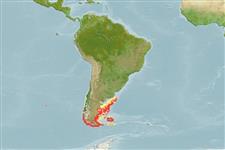Common names from other countries
Classification / Names / Names
Common names | Synonyms | Catalog of Fishes (gen., sp.) | ITIS | CoL | WoRMS
Environment: milieu / climate zone / depth range / distribution range
Ecology
Sessile; depth range 0 - 90 m (Ref. 83435). Temperate; 38°S - 56°S, 74°E - 57°E (Ref. 83435)
Southeast Pacific and Southwest Atlantic: Chile, Falkland and Argentina.
Length at first maturity / Size / Weight / Age
Maturity: Lm ? range ? - ? cm Max length : 2.4 cm DL male/unsexed; (Ref. 83435)
It is found on rocky substrates, on or beneath rocks, in rock crevices, rocky walls and tide pools, and on brown algae (Ref. 87801), like forests of Macrocystis pyrifera (Ref. 92889).
Life cycle and mating behavior
Maturity | Reproduction | Spawning | Eggs | Fecundity | Larvae
Egg masses are composed of 4 to 19 egg capsules, containing 1 to 5 embryos developing within each capsule and emerges as crawling juveniles. Egg capsules are attached to a substrate.
Rosenberg, G. 2009. (Ref. 83435)
IUCN Red List Status (Ref. 130435)
CITES status (Ref. 108899)
Not Evaluated
Not Evaluated
Human uses
| FishSource |
Tools
More information
Age/Size
Growth
Length-weight
Length-length
Morphology
Larvae
Abundance
Internet sources
Estimates based on models
Preferred temperature
(Ref.
115969): 6.3 - 13.1, mean 8.6 (based on 194 cells).
Price category
Unknown.
